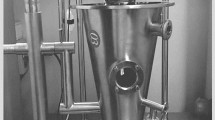Abstract
Porous calcium carbonate material has been modified with a sulpha drug, sulphanilamide, proposed to be used as a dressing material. The material was found to have a better drug loading if modified using a polymer, polyethylene glycol (PEG#12000), used during synthesis of the material. This modified drug delivery matrix has been characterized through TEM, FESEM, FTIR, surface analysis, and powder XRD and compared with those of the unmodified ones. The materials were found to have mixed porosity in the macroporous to mesoporous range, and the modifications were supported by the results of FTIR, TEM, and FESEM. One of the PEG-modified matrix was found to have satisfactory drug loading and sustained release properties. For studies on drug release, a solution of physiological pH (5.5), 0.3% and 0.9% NaCl solutions of pH 5.5 were chosen to mimic the different conditions of skin to simulate a sustained release application for the treatment of wounds.

ᅟ





Similar content being viewed by others
References
Russo E, Concia F, Cristini F, De Rosa FG, Esposito S, Menichetti F, Petrosillo N, Tumbarello M, Venditti M, Viale P, Viscoli C, Bassetti M (2016) Current and future trends in antibiotic therapy of acute bacterial skin and skin-structure infections. Clin Microbiol Infect 22:S27–S36. https://doi.org/10.1016/S1198-743X(16)30095-7
Hwang IY, Koh E, Kim HR, Yew WS, Chang MW (2016) Reprogrammable microbial cell-based therapeutics against antibiotic-resistant bacteria. Drug Resist Updat 27:59–71. https://doi.org/10.1016/j.drup.2016.06.002
Stebbins ND, Ouimet MA, Uhrich KE (2014) Antibiotic-containing polymers for localized, sustained drug delivery. Adv Drug Deliv Rev 78:77–87. https://doi.org/10.1016/j.addr.2014.04.006
Begum G, Reddy TN, Kumar KP, Dhevendra K, Singh S, Amarnath M, Misra S, Rangari VK, Rana RK (2016) In situ strategy to encapsulate antibiotics in a bioinspired CaCO3 structure enabling pH-sensitive drug release apt for therapeutic and imaging applications. ACS Appl Mater Interfaces 8(34):22056–22063. https://doi.org/10.1021/acsami.6b07177
Guo Y, Li H, Shi W, Zhang J, Feng J, Yang X, Wang K, Zhang H, Yang L (2017) Targeted delivery and pH-responsive release of doxorubicin to cancer cells using calcium carbonate/hyaluronate/glutamate mesoporous hollow spheres. J Colloid Interface Sci 502:59–66. https://doi.org/10.1016/j.jcis.2017.04.085
Sharma S, Verma A, Teja BV, Pandey G, Mittapelly N, Trivedi R, Mishra PR (2015) An insight into functionalized calcium based inorganic nanomaterials in biomedicine: trends and transitions. Colloids Surf B: Biointerfaces 133:120–139. https://doi.org/10.1016/j.colsurfb.2015.05.014
Peng H, Li K, Wang T, Wang J, Wang J, Zhu R, Sun D, Wang S (2013) Preparation of hierarchical mesoporous CaCO3 by a facile binary solvent approach as anticancer drug carrier for etoposide. Nanoscale Res Lett 8(1):1–11. https://doi.org/10.1186/1556-276X-8-321
Zhang J, Li Y, Xie H, Su B-L, Yao B, Yin Y, Li S, Chen F (2015) Calcium carbonate nanoplate assemblies with direct high-energy facets: additive-free synthesis, high drug loading, and sustainable releasing. ACS Appl Mater Interfaces 7(29):15686–15691. https://doi.org/10.1021/acsami.5b04819
Hariharan M, Varghese N, Cherian AB, Sreenivasan PV, Paul J, Antony AKA (2014) Synthesis and characterisation of CaCO3 (calcite) nano particles from cockle sheels using chitosan as precursor. IJSRP 4(10):1–5
Saraya ME-SI, Rokbaa HHAL (2016) Preparation of vaterite calcium carbonate in the form of spherical nano-size particles with the aid of polycarboxylate superplasticizer as a capping agent. Am J Nano 4(2):44–51. https://doi.org/10.12691/ajn-4-2-3
Tsuzuki T, Pethick K, McCormick PG (2000) Synthesis of CaCO3 nanoparticles by mechanochemical processing. J Nanopart Res 2(4):375–380. https://doi.org/10.1023/A:1010051506232
Schwartz IL, Thaysen JH (1956) Excretion of sodium and potassium in human sweat. J Clin Invest 35(1):114–120. https://doi.org/10.1172/JCI103245
Herrmann F, Mandol L (1955) Studies of pH of sweat produced by different forms of stimulation. J Investig Dermatol 24(3):225–246. https://doi.org/10.1038/jid.1955.36
Xiang Y, Han J, Zhang G, Zhan F, Cai D, Wu Z (2018) Efficient synthesis of starch-regulated porous calcium carbonate microspheres as a carrier for slow-release herbicide. ACS Sustain Chem Eng 6:3649–3658. https://doi.org/10.1021/acsuschemeng.7b03973
Sung K, Kim W, Bang J-H, Park S, Jeon CW (2015) Polymorphs of pure calcium carbonate prepared by the mineral carbonation of flue gas desulfurization gypsum. Mater Des 83:308–313. https://doi.org/10.1016/j.matdes.2015.06.051
Sing KSW (1982) Reporting physisorption data for gas/solid system with special reference to the determination of surface area and porosity. Pure Appl Chem 54(11):2201–2218. https://doi.org/10.1351/pac198254112201
Rojas F, Kornhauser I, Felipe C, Esparza JM, Cordero S, Domínguez A, Riccardo JL (2002) Capillary condensation in heterogeneous mesoporous networks consisting of variable connectivity and pore-size correlation. Phys Chem Chem Phys 4:2346–2355. https://doi.org/10.1039/B108785A
Acknowledgements
Pritam Singh gratefully acknowledges the University Grants Commission (UGC) (Ref. No. 20/12/2015(ii)EU-V dated 24.08.2016) for providing necessary fellowship. We also express our sincere gratitude to Mr. Nayan Ranjan Saha, Department of Chemical Technology, University of Calcutta, India, for measuring the XRD and Mr. Ashutosh Mishra, Research Scholar, Department of Chemistry, IIT BHU, for XRD analysis.
Author information
Authors and Affiliations
Corresponding author
Ethics declarations
Conflict of interest
The authors declare that they have no conflict of interest.
Electronic supplementary material
ESM 1
(DOCX 916 kb)
Rights and permissions
About this article
Cite this article
Singh, P., Sen, K. Drug delivery of sulphanilamide using modified porous calcium carbonate. Colloid Polym Sci 296, 1711–1718 (2018). https://doi.org/10.1007/s00396-018-4392-x
Received:
Revised:
Accepted:
Published:
Issue Date:
DOI: https://doi.org/10.1007/s00396-018-4392-x




